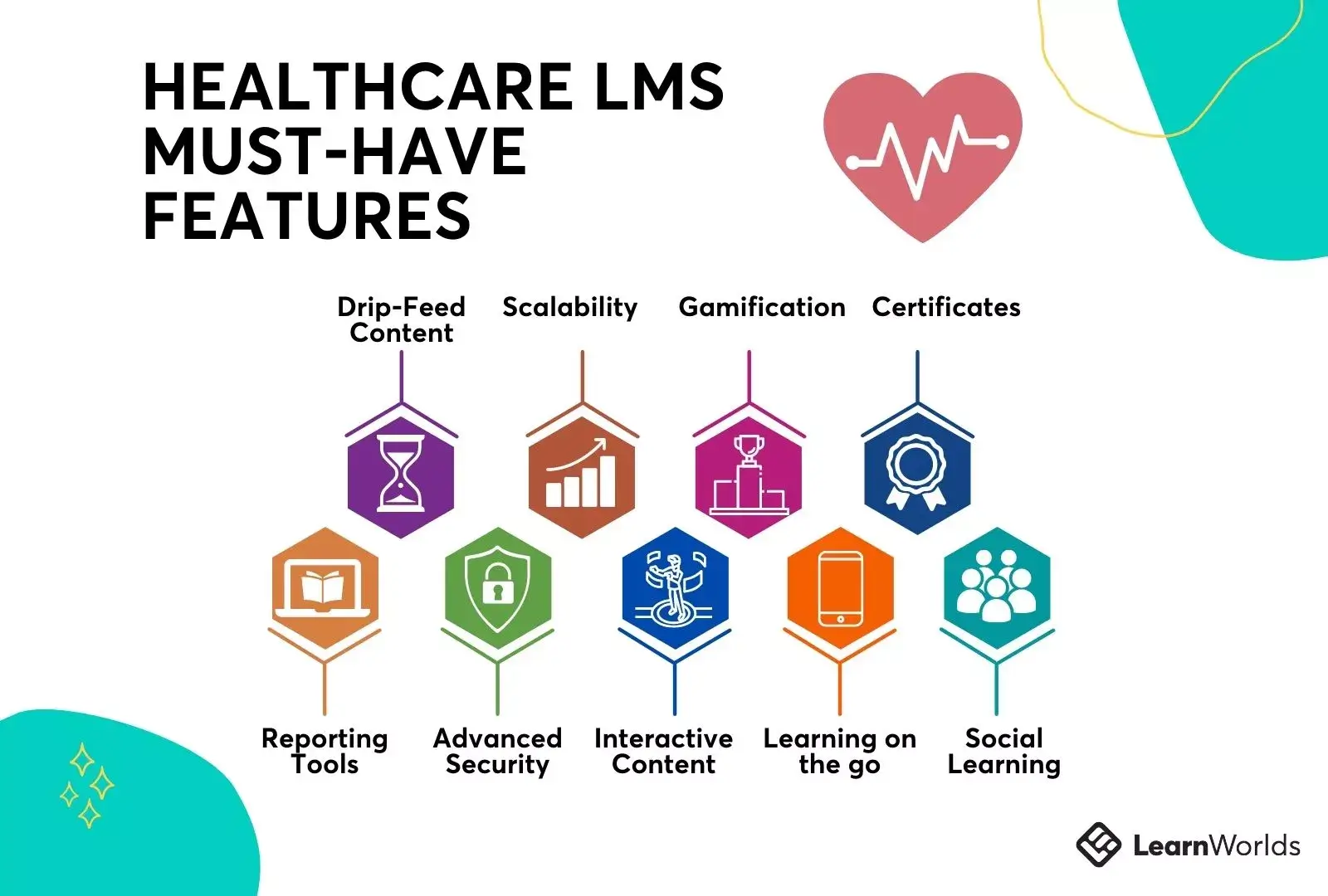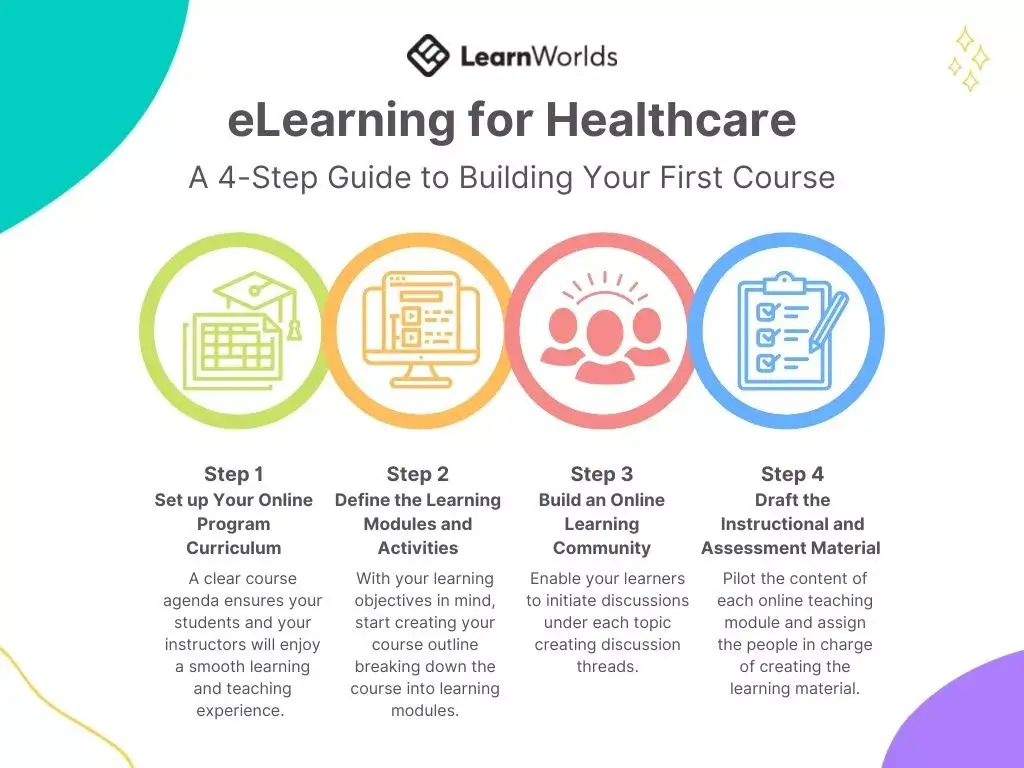Table of Contents
The acceleration of remote teaching and online learning, along with the development of advanced and user-friendly learning management systems (LMSs) have broadened the horizons for healthcare organizations as well.
You now have new ways and innovative tools at hand to train your staff and monetize your healthcare business. You can effortlessly create a dedicated community of lifelong learners who can learn at their own pace, regardless of where they are located.
Sounds intriguing but don’t know where to start?
We have compiled a practical guide for healthcare organizations tο put into action. It’s a step-by-step roadmap to design and implement your first online course as a health professions educator.
We’re also discussing the features that LMS systems for healthcare must include, so you pick the top healthcare LMS! We have even included examples of topics you can teach that will appeal to people besides healthcare professionals.
Finally, we’re showing you why LearnWorlds is the top choice to build your program.
But first…
What is a Healthcare LMS?
In the hectic healthcare environment, you can still ensure a smooth educational experience inside and outside of your business. To do so, you’ll need to invest in a healthcare LMS.
A healthcare LMS is a software that allows healthcare organizations to build their training courses fast and easily, this way enabling continuing medical education (CME). These courses are usually developed to train medical professionals, who need to stay up to date with the changing guidelines and procedures and emerging technologies.
A healthcare organization can also educate through their courses a wider audience. Healthcare mostly attracts people who are already in healthcare and are looking to get additional qualifications or a specialization. Healthcare courses, when they’re not too specialized, also appeal to anyone interested in learning about physical and mental health from a reliable source.
Essentially, a healthcare Learning Management System isn’t any different than the typical LMS. What makes vendors position their product under the healthcare category? The fact that their LMS has certain features that facilitate healthcare training.
Choosing the Best LMS for the Healthcare Industry: 9 Must-Have Features
How do you pick the best LMS software? If you don’t know what to look for, here are a few ideas from us:

1Drip-Feed Content
Drip feeding is releasing the content of your course in predetermined time intervals or on specific dates. For example, you can choose to unlock the first module one week after a learner signs up, the second one two weeks after, and so on. Or, you can release content on specific dates only.
Drip feeding is an effective way to prevent learners from going through the course too fast without really assimilating the information. There are reliable ways to measure how much they’ve learned. However, drip-feeding at least puts a stop to learners browsing through the course. This is an essential feature all healthcare eLearning solutions should offer.
2Interactive Content
It’s harder to engage learners in an online learning environment than in a classroom. Creating interactive content, though, is very effective in catching the learners’ attention and keeping them focused. We’re talking about content like a training video with pop-up questions or an eBook with embedded quizzes, or HIPAA-compliant forms that make it fun to offer feedback.
Interactive training material takes learners out of a passive state of learning. It brings them back to the lesson and poses questions and prompts them to take some action. This helps learners analyze what they’re learning while they’re learning it.
3Social Learning
Double-check that your LMS has social learning features, like a built-in discussion forum.
Social learning elements are essential for all courses. But all the more so in asynchronous learning where interaction with peers and the instructor is rare and limited. On top of that, we learn better in informal settings and during spontaneous activities that involve sharing of information.
4Certificates
Whether your course is addressed to healthcare professionals or a wider audience, it’s always a good idea to offer a certificate. People are taking your course to learn and become better. A certificate gives an extra reason to join because it validates and rewards their effort to learn. In fact, certificates are pretty standard in online courses. So, there’s no question whether your LMS offers this option or not – it absolutely should!
5Reporting Tools
You need an LMS with advanced reporting functionality for two reasons: to measure learner progress and to gauge the overall effectiveness of the course. Your LMS should give you insights about metrics like course completion rates, average scores, and more.
Reporting is all the more important for compliance training. Compliance management is a big issue in the healthcare industry. Medical staff needs to be fully familiar with safety procedures, as the disposal of medical waste.
Otherwise, they might jeopardize their own health and the environment. With advanced reporting features, you can monitor safety or compliance training at a glance. This way, you ensure that everyone has successfully met the learning objectives of the course and is following procedures as they should.
6Advanced Security
It doesn’t matter whether you’re deploying internal training programs, extended enterprise, or medical elearning courses for a wide audience. You need to know that learner data, company patents and know-how, and patient information are safe.
Learning solutions for the healthcare industry need to offer advanced security features so that sensitive information doesn’t leak or gets distroyed. Ask your vendor what tools and processes they have in place to secure your data and protect your online academy from cyberthreats. Look for features like data encryption, regular back-ups, Single Sign-On (SSO), and powerful anti-virus.
7Scalability
Scalability is another feature to consider. As you grow your business and offer online training courses to a wide audience, your training platform should be able to keep up with and address your growing needs.
So check with the healthcare Learning Management System vendor the level of customer support they provide. Is there a dedicated account manager for high-volume accounts? How do they make sure their servers support surges in traffic and the number of users?
8Learning on the go
We all hold our mobile devices dear to our hearts and…our hands. Therefore, for a truly self-paced and flexible learning experience, choose a mobile-friendly LMS that plays well on mobile.
Want to take it a step further? Enable your learners to learn not only at their own pace but also on the go with a healthcare training LMS that offers a mobile app. With in-app notifications and reminders, you’ll communicate with learners in a more direct way and engage them more.
Offering immediate access to training material, a mobile app is also an excellent performance support tool. Learners can access their course in a heartbeat to check what they need, avoiding mistakes and unnecessary stress. A mobile app is an essential offering for medical training in general and for onboarding new healthcare employees.
9Gamification
All work and no play can be boring. Your learning platform should be a fun platform too. Gamification makes the learning process more entertaining and remotivates learners before they lose their interest.
Reward your learners with badges, for example, to say “kudos” and have them try their best to collect them all. And as they collect badges, they learn more! Not to mention that healthcare topics can get a bit heavy, so learners need the distraction of a fun element.
eLearning for Healthcare: A 4-Step Guide to Building Your First Course
Let’s get to the most exciting part of the journey! See how you can build your first course following a 4-step process.

1Set up Your Online Program Curriculum
Just as you would build a course flow for your classroom teaching, the same way you have to design your online course’s curriculum. With a clear course agenda, you can ensure that your students and your instructors will enjoy a smooth learning and teaching experience respectively.
Invest some time to create an introductory video wherein you will present the course flow and set the expectations right from the start.
You can develop the course curriculum following David Kern’s six-step approach to curriculum development for medical education:
As you design the course for online teaching, you do not have to follow the steps one after the other. You can change the sequence and start with identifying the skills that your students will gain as soon as they complete your course.
These are your learning objectives, and they play a central role in course development. Next, you can plan which additional elements you’ll add to the course, such as assignments or activities, leveraging the eLearning platform’s functionality.
2Define the Learning Modules and Activities
With your learning objectives in mind, start creating your course outline, breaking down the course into learning modules. Modern Learning Management Systems, like LearnWorlds, make it super easy for you to add and configure your learning modules.
Make sure you define the learning objectives in every module (what your students are expected to learn by the end of each module) and the activities they need to take (e.g., quiz, assignment, exam).
Usually, the learning objectives determine the type of assessment. For example, if you have set a knowledge-based learning objective, you may want to assess it using a test, instead of a practical assignment. The more theoretical the topic you’re teaching, the more you will rely on open-ended questions and quizzes.
Using an online gradebook, you can easily insert and update grades and keep track of learner progress. A gradebook also helps you spot remaining knowledge gaps or ineffective content, allowing you to make the necessary changes to improve your course.
As a best practice, we advise you to keep your online course flow consistent and create a set of similarly structured modules throughout the course to set clear expectations for the learners.
Of course, you may apply diverse educational strategies to make your learning content more interesting and avoid repetition. Also, try adding interactive elements to your video healthcare courses to further increase learner engagement.
3Build an Online Learning Community
Most healthcare professions rely on discussion and case study analysis. To create a similar opportunity for your online course, integrate a community of learners as a side learning activity.
Consult with your human resources to have the entire class, including your health professions instructors, actively participate in the discussion forums of your online programs.
Based on the online course curriculum you have designed, you can set a list of topics for discussion. Allow your learners to initiate discussions under each topic, creating discussion threads. This online community will increase interactivity and further cultivate learner engagement by providing a friendly environment for questions and answers.
The peer-to-peer discussion will encourage learners to collaboratively analyze case studies and research projects related to your online course’s modules. This will make your online teaching more interesting and realistic. You can even use an online learning community as a digital room for your learners to present their final assignments or projects.
4Draft the Instructional and Assessment Material for Your Program
In case you have a faculty of instructors in your healthcare business, meet with them to pilot the content of each online teaching module. Assign the people in charge of creating the text material, the video presentations, the live sessions, the podcasts, the assignments, the quizzes, all the pieces of educational content that will accompany your online course.
A comprehensive LMS solution will facilitate the whole process for you, as it features user-friendly authoring tools that will make your life easier. You do not have to rely on an information technology instructor to guide you through content creation.
The authoring tools are super easy to use, with visual and drag-and-drop functionality. So, your instructors can feel comfortable while creating and teaching your online course.
Keep in mind to also create and upload any additional resources for advanced learning that your learners can check out as further related readings to your online course’s topic. The healthcare industry is all about studies, surveys, prevention, treatments, patient care, and advances in the field.
Provide your learners with an online library that goes beyond the required online materials and includes reading resources, useful links, and case studies relevant to the topic of your online course. Not only do you facilitate your students’ learning process but you also add value and enrich your online course’s topic.
At this point, we also advise you to create feedback material to collect reactions, reviews, and evaluations from your learners. Feedback will help you assess the impact of your online course (e.g., the effectiveness of the course flow, learner satisfaction, the instructor’s presence, and study load) and take corrective actions if needed.
There are several topics that are suitable for online learning. You can create courses to educate your audience about physical and mental diseases, raise awareness on mental health issues, help healthcare professionals improve their day-to-day, introduce new technologies, and discuss regulatory or compliance topics.
Let’s see a few examples:
How LearnWorlds Meets Your Healthcare Training Needs
We believe that LearnWorlds is the best training solution for your healthcare business. Whether you want to onboard new employees, offer continuing education to your staff, or sell to a wider audience, LearnWorlds can support all your needs.
And we’re not all talk: you name it, we’ve got it!
Start Monetizing Your Healthcare Business
It’s important to facilitate access to training for healthcare professionals and to raise awareness and educate the general public about health issues. Using an LMS and following the advice we’ve shared with you today, you can now choose a topic and start planning your first online healthcare course.
We advise you to select a subject in your area of expertise, which is also currently trending, to make sure it will attract learners. Hopefully, you’ll find some inspiration among our suggested topics.
Are you still wondering what the top LMS for healthcare is? If you feel that you need a bit more motivation to kickstart your first healthcare online course, sign up for a free online 30-day trial with LearnWorlds. You will be amazed at how easy it is to create your healthcare lessons online today!
Further reading you might find interesting:

Androniki Koumadoraki
Androniki is a Content Writer at LearnWorlds sharing Instructional Design and marketing tips. With solid experience in B2B writing and technical translation, she is passionate about learning and spreading knowledge. She is also an aspiring yogi, a book nerd, and a talented transponster.
Rosemary is LearnWorlds’ Content Marketing Manager. She has over 2 decades of experience in omnichannel marketing and content writing for the IT and SaaS industry. Her expertise lies in crafting effective content marketing strategies that attract, engage, and nurture customers, enabling LearnWorlds to reach its target audiences with precision.


